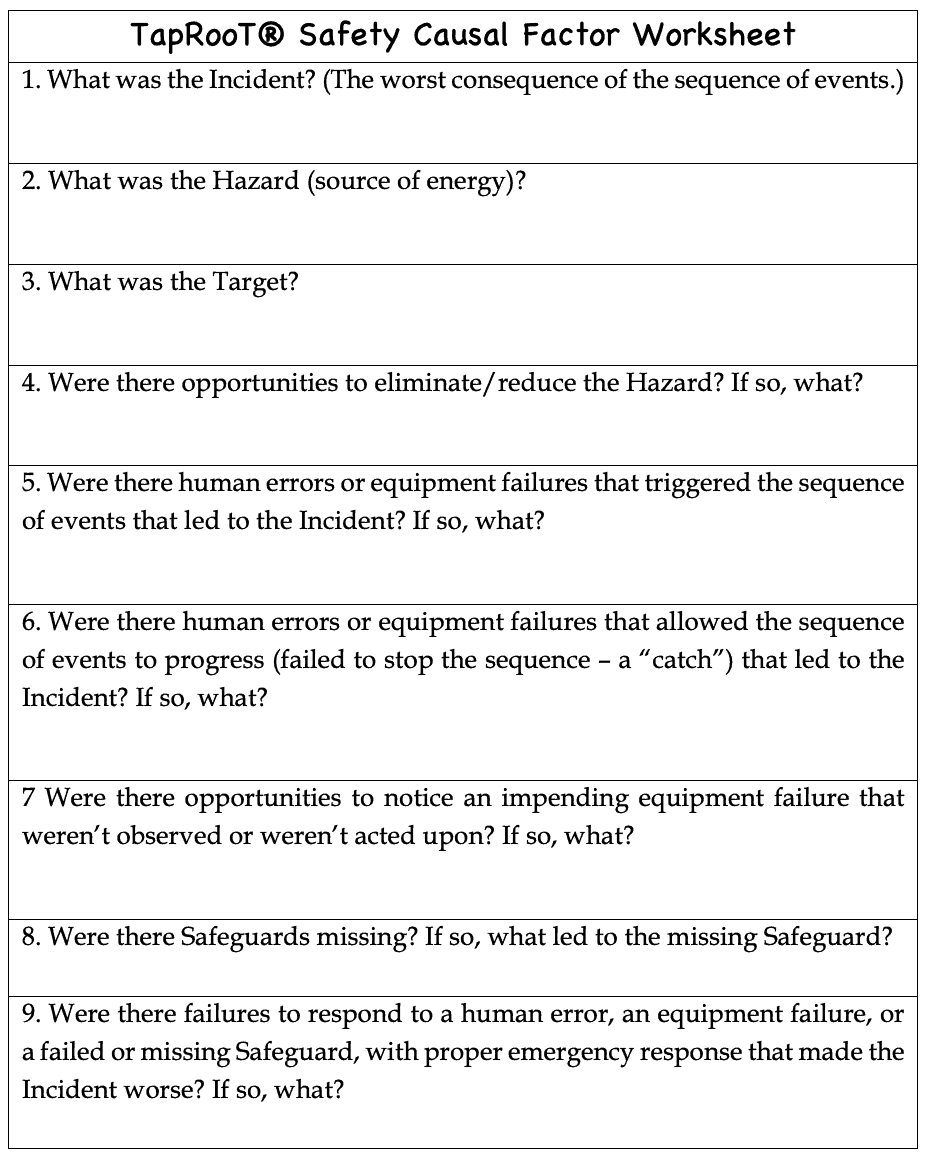How To Do a Root Cause Analysis of the New Orleans Building Collapse

Root Cause Analysis New Orleans Building Collapse
How To: Root Cause Analysis of the New Orleans Building Collapse – Before starting the root cause analysis, here’s the video of the collapse…
First, let’s pray for the loved ones of those that were killed and those injured.
Now … How do you find the root causes?
A fatality investigation is never easy. But you can apply a proven process to find the accident’s root causes.
TapRooT® Root Cause Analysis – Step 1
This is a major investigation. Therefore, TapRooT® Users would start by putting what they know about the New Orleans building collapse on a SnapCharT® and start planning their root cause analysis investigation. That’s Step 1 of the TapRooT® 7-Step Major Investigation process (shown below)…

TapRooT® Root Cause Analysis – Step 2
Now that you have a plan, you start collecting information using the TapRooT® 12-Step Cognitive Interviewing Process, Equifactor®, CHAP, and Change Analysis. All the evidence you collect about the building collapse is organized to tell the story of what happened on your SnapCharT®. You have to know what happened before you can find the root causes.
TapRooT® Root Cause Analysis – Step 3
Once you understand what happened, you are ready for the Analysis Phase and Step 3 – defining the Causal Factors.
In a major investigation, there are always multiple Causal Factors. How do you identify them all? You could use the three-question method from the Using TapRooT® Root Cause Analysis for Major Investigations book.

Or, you could use the new TapRooT® Safety Causal Factor Worksheet…

The new worksheets (there are four different sheets) will be launched at the 2020 Global TapRooT® Summit.
TapRooT® Root Cause Analysis – Step 4
Time to find the root causes of every Causal Factor for the building collapse.
Can there be more than one root cause? Of course! There can be multiple root causes for each Causal Factor.

In Step 4, you use the TapRooT® Root Cause Tree® and the Root Cause Tree® Dictionary – a guided root cause analysis process – to find the real, fixable root causes of the building collapse’s Causal Factors. Note that the TapRooT® Root Cause Tree® and the Root Cause Tree® Dictionary come with the Using TapRooT® Root Cause Analysis for Major Investigations book.
The guided root cause analysis will help you find the root causes that you previously would have overlooked.
TapRooT® Root Cause Analysis – Step 5
Did you think that finding root causes for the building collapse was the end of your root cause analysis? No way! The TapRooT® 7-Step Major Investigation Process guides you to look for Generic Causes.
What? You don’t know what Generic Causes are? Then you need to read the Using TapRooT® Root Cause Analysis for Major Investigations book.
But let me give you a hint … Generic Causes are the systemic root causes of the root causes.
TapRooT® Root Cause Analysis – Step 6
Time to review your root causes and Generic Causes and develop effective “fixes.” We usually call these corrective actions. And in the TapRooT® System you have the Corrective Action Helper® Guide to help your investigators develop effective corrective actions that work.
TapRooT® Root Cause Analysis – Step 7
Time to present what you found (the root causes) and the corrective actions to management for approval. Lucky for you that the TapRooT® Software makes the whole investigation process and the presentation easy. Even for root cause analysis of a major investigation, like the one for the New Orleans building collapse.
What is Special About the New Orleans Building Collapse Root Cause Analysis?
You have seen steps in the TapRooT® 7-Step Major Investigation Process and you may be wondering …
What’s special (different) about the New Orleans building collapse root cause analysis?
First, some of the evidence is buried in the rubble. That makes evidence collection more difficult.
Second, there is at least one fatality. This makes interviews more difficult because some may not want to talk and lawyers may be involved.
Third, because of the fatality, regulatory agencies will be involved and evidence will be at least need to be shared. Plus, evidence will need to be preserved for future legal action that almost certainly will follow.
Finally, in many fatality investigations, the person killed may have been a key witness.
The complications in all fatality investigations mean one thing …. It is much easier to learn from precursor incidents than it is to learn from the root cause analysis of a fatality investigation. And much cheaper.
What Root Causes Will Investigators Find?
This kind of investigation has certain common similarities. Almost always the root cause analysis will look into:
- Rules or Standards being violated.
- Shortcuts being taken.
- Previous warnings being disregarded.
Can we guarantee that these three things were involved in the root causes of this building collapse? NO.
But you seldom have a major accident where shortcuts and broken rules aren’t involved (rules are there to keep things safe) and warnings didn’t happen.
That’s why it is so important to do good precursor incident investigations (the warning investigations) and stop the normalization of deviation (where rule-breaking becomes common).
Learn More About TapRooT® Root Cause Analysis
Want to learn how to Use TapRooT® to do good precursor incident root cause analysis investigations and to investigate major accidents? Then you need to attend the 5-Day TapRooT® Root Cause Analysis Team Leader Training. See the upcoming public 5-Day TapRooT® Courses at this link:
https://www.taproot.com/store/5-Day-Courses/
Drone Video of New Orleans Building Post-Collapse
What evidence can you gather by watching this post-collapse video?
And what can you learn from the first video?



